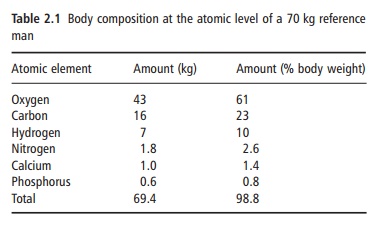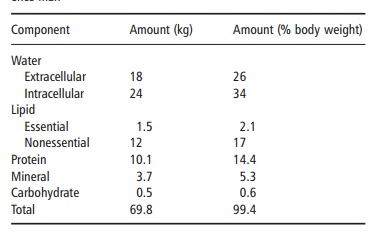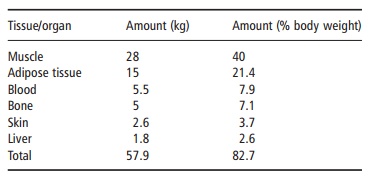Chapter: Introduction to Human Nutrition: Body Composition
Five levels of body composition
Five levels of body composition
Human body composition can be studied at the atomic, molecular, cellular, tissue, and whole body level. These five levels are related to each other. For example, information at the atomic level can be used, subject to certain assumptions, to provide informa-tion at the whole body level.
Atomic level
Many chemical elements (atoms) are found in the human body, but the six elements oxygen, carbon, hydrogen, nitrogen, calcium, and phosphorus are the most abundant and together account for more than 98% of body weight (Table 2.1). Indeed, the 11 most common elements account for 99.5% of the atomic body composition. This information was initially based on chemical analysis of carcasses, but today the information can also be obtained by in vivo neutron activation analysis (IVNAA). The classical chemical cadaver analysis, as carried out mainly in the 1940s

Molecular level
The chemical elements in the human body are bound in molecules and, in very global terms, the main com-partments are water, lipids, proteins, minerals, and carbohydrates. The total amount of water in the body is high and, depending on the body fat content, can be as high as 60–70% of total body weight. Total body water can be divided into intracellular water and extracellular water, and the ratio of the two is an important health parameter that is disturbed in many diseases.
Lipids appear in the human body in different forms. Essential structural lipids such as the phospho-lipids (cell membranes) and sphingomyelin (nervous system) form only a minor part of the total lipids in the body. The nonessential lipids, mostly triglycerides or triacylglycerol (fat), are the most abundant. They are the energy store of the adult human body, insulate against cold, protect vital organs such as the kidneys against mechanical damage, and, to a certain extent, enhance the body’s appearance. In a “normal weight” healthy adult, the amount of body fat varies between10% and 25% in men and between 15% and 35% in women. In severe obesity body fat can be as high as 60–70% of body weight.
Table 2.2 Body composition at the molecular level of a 70 kg refer-ence man

Component Amount (kg) Amount (% body weight)
Water
Extracellular 18 26
Intracellular 24 34
Lipid
Essential 1.5 2.1
Nonessential 12 17
Protein 10.1 14.4
Mineral 3.7 5.3
Carbohydrate 0.5 0.6
Total 69.8 99.4
Body protein varies between 10% and 15%. It is higher in males than in females, as males generally have more muscles. There is no protein storage in the body and, generally speaking, loss of protein coincides with a loss of functionality given the high protein content and high protein turnover rates in vital organs.
The amount of minerals in the body varies between 3% and 5%, again dependent on body fat. Calcium and phosphorus are the two main minerals. They are found mainly in bones. Carbohydrates are found in the body as glucose (blood sugar) and glycogen, a polysaccharide in muscle and liver cells that serves as a short-term energy store. The amount of carbohy-drates in the body rarely exceeds 500 g. Table 2.2 gives the body composition of the reference man at a molecular level.
Cellular level
At the cellular level, body composition can be described in terms of body cell mass, extracellular fluids, and extracellular solids. The body cell mass includes the cells with all their contents, such as water, proteins, and minerals. Extracellular fluid contains about 95% water, which is plasma in the intravascular space and interstitial fluid in the extravascular space. Extracellular solids are mainly proteins (e.g., colla-gen) and minerals (bone minerals and soluble miner-als in the extracellular fluid). Body composition at the cellular level is not easy to measure, owing to its complex nature. As will be discussed later, the 40K method can be used to assess body cell mass and some dilution techniques, for example bromide dilution, can be used to assess extracellular water.
Table 2.3 Body composition at the tissue level of a 70 kg reference man

Tissue/organ Amount (kg) Amount (% body weight)
Muscle 28 40
Adipose tissue 15 21.4
Blood 5.5 7.9
Bone 5 7.1
Skin 2.6 3.7
Liver 1.8 2.6
Total 57.9 82.7
Tissue level
Cells with equal functions form tissues, including muscular, connective, epithelial, and nervous tissue. Bones are connective tissue and consist mainly of hydroxyapatite, [Ca3(PO4)2]3Ca(OH)2, bedded in a protein matrix. A rather simple body composition model at the tissue level would be:
Body weight = adipose tissue + skeletal muscle + bone + organs + rest
Several of these components can now be measured with, for example, computed tomography (CT) or magnetic resonance imaging (MRI) for adipose tissue; creatinine excretion or N-methyl-histidine excretion in 24 h urine for skeletal muscle; dual-energy X-ray absorptiometry (DXA) for bones; and MRI or ultra-sound for organs. Body composition at the tissue level is given in Table 2.3.
Whole body level
Body composition measurements at the whole body level use simple body parameters to give an insight into body composition. Formulae, based on statistical relationships that have been established in earlier studies between body parameters (e.g., skinfold thick-ness) and information on body composition (e.g., body fat by density), also enable the assessment of body composition. Another example is the assess-ment of body water based on weight, height, age, and gender.
Related Topics